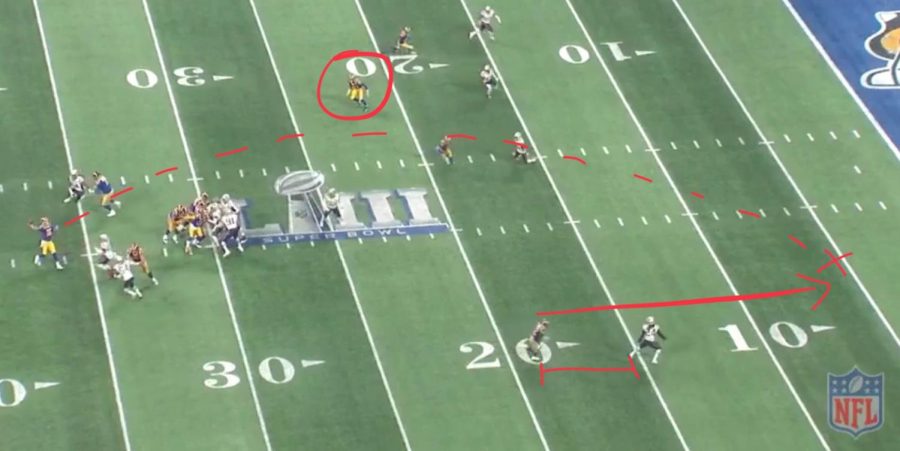How the Patriots won the Super Bowl (again)
Bill Belichick used carefully designed blitz packages to shut down the Rams
For many, Super Bowl LIII was a complete dud. Zero touchdowns were scored until New England Patriots running back Sony Michel found pay dirt in the fourth quarter. His team ended up beating the LA Rams by a score of 13-3.
However, what may have seemed like an offensive disaster for the Rams was actually an exhibition in defensive scheming and execution for the Patriots, led by legendary head coach Bill Belichick.
A perfect example of this is when cornerback Stephon Gilmore intercepted Rams QB Jared Goff deep in Patriots territory and late in the fourth quarter, all but putting the game away. I took a look at how Belichick forced Goff into a massive mistake.
Even before the snap on this fateful play, the Rams were in big trouble. New England displayed a very common defensive tactic: showing a blitz from one side and bringing one from the other.
The image above is how the Patriots lined up, and the red arrows show where the Rams thought that the Patriots’ attackers (safety Devin McCourty, 32, and linebacker Kyle Van Noy, 53) were coming from.
To counter this standard six-man rush, the Rams used this protection scheme:
It’s a gap scheme on the offense’s left and a man scheme on its right. The center, left guard, and left tackle take whoever shows up in the gap to their left, and the right guard, right tackle and running back Todd Gurley are locked onto an individual rusher, shown by the red lines above.
This, however, is exactly what New England wanted LA to think and do. Instead of sending Van Noy, they actually drop him into coverage and bring safety Duron Harmon (21), overloading the offense’s right. Because the protection scheme anticipated a different pressure than they got, nobody could possibly account for Harmon, as shown below with the red arrows.
The result: a completely free lane for Harmon and thus a free shot at Goff.
Now, Goff is in deep trouble. He cannot take time to find a down field receiver, so instead he has to go to his hot read, or designated receiver to hit in case a free blitzer comes in.
This is where a key fact that Belichick was counting on comes into play: Jared Goff is terrible when pressured. He is arguably elite when he has time and space to throw, but he can’t function with defenders in his face. What happened next was the norm, not the exception. And the Patriots knew it.
It is reasonable to suspect that his hot read was Josh Reynolds (circled in red, right), who was the only receiver running a quick route for an easy throw.
The Patriots’ secondary was in cover zero, which means each non-rusher is in man coverage with no deep safety help, and were giving a large amount of space between themselves and their men so they wouldn’t give up a big play.
Because of this, Reynolds was wide open for an easy five-yard completion – or even more if he was able to get past his defender.
In contrast to what he should have done, Goff inexplicably never even looked in Reynolds’s direction. He instead tried to throw a go route to Brandin Cooks, and due to All-Pro CB Stephon Gilmore (24) playing off coverage, Cooks never had a prayer, and Gilmore easily picked it off.
It’s easy to say “Goff just screwed up.” And to be fair, he did. But the mistakes he made were ones that New England knew he would make, and if they could manage to force him into making them enough, they would win the game.
This is much easier said than done against prodigy 33-year-old head coach Sean McVay and the Rams. If it were easy, they wouldn’t be in the Super Bowl. That’s what makes it so impressive that the Patriots – like our Chicago Bears before them, but with far inferior defensive talent – completely cracked the code.
And this is why I thoroughly enjoyed Super Bowl LIII. It may not have been the offensive extravaganza that many anticipated; rather it was a fascinating defensive chess match. Belichick flustered Goff and coached circles around McVay as he led New England to their sixth Lombardi trophy.







































